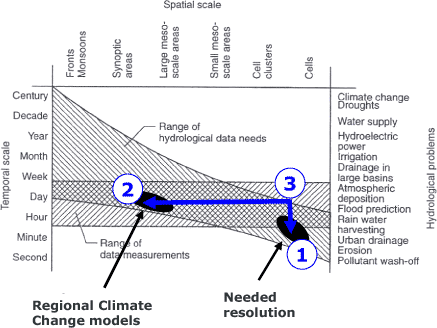|
| Forside | | Indhold | | Forrige | | Næste |
Klimaeffekters betydning for ekstremregn og dermed funktionen af afløbssystemer
Summary and conclusions
Significant changes in precipitation patterns have been observed within the last few decades. This development is expected to continue. The number of precipitation events will decrease. Extreme
precipitation will, however, occur more frequently.
Changes in the precipitation structure have a significant influence on the performance of sewer systems. Preliminary assessment indicates that, at some locations, the capacity of urban sewerage systems must
be doubled to avoid severe damage to urban areas.
Precipitation data from global and regional climate change models are not immediately applicable for calculation of urban runoff because the resolution is too coarse; design and analysis of urban runoff are
most often based on point rainfall in a high temporal resolution. The data must therefore be processed further before the consequences for urban runoff can be evaluated.
The objective of the project is to identify methods that are suitable for deriving the scaling properties of precipitation. An overview of methods used to describe the scaling properties of precipitation enables
the selection of suitable methods to use the results from climate change models when predicting future occurrences of extreme rainfall and the impact on urban areas.
Three methods have been identified. The three methods all apply the following procedure:
- Characterize precipitation in point measurements based on historical rainfall series.
- Characterize a similar property in a regional climate change model covering the region in question and quantify the difference between "status" and "future".
- Establish an unambiguous relationship between the historic precipitation series and the "status" simulation of the climate model. The unambiguous relationship is used to describe the properties of point
precipitation in a future scenario.
The three steps are presented in figure 2.
The three methods can be summarized as follows:
- Empirical processing of extreme values for different return periods and durations. The relationship between the point precipitation data and the climate change model data is established as a fixed ratio,
the so-called Areal Reduction Factor. This method has been applied in Denmark.
- Parametric modelling of extreme values by means of the Partial Duration Series (or Generalized Extreme Value) approach. The relationship between the point precipitation series and the climate
change model is established by correlating parameters in the models for each duration in question.

Figur 2 The steps needed in order to transform predicted changes in extreme precipitation from Regional Climate Change models to a resolution needed in urban drainage.
- Parametric modelling of precipitation series in a coarse temporal resolution combined with methods for scaling of precipitation in higher temporal resolutions. The relation between precipitation series
and climate model is established by correlating parameters in the models. The method has been applied in Great Britain.
The first of the above mentioned methods has been tested on Danish data as part of a Master thesis at the Technical University of Denmark. The results were quite alarming in the sense that the predicted
future extreme precipitation was much more intense than today. The first method is, however, expected to be the most uncertain method. Therefore it is recommended to initiate a project with an assessment
based on one of the two other methods and/or to evaluate the importance of the assumptions in the applied method. By evaluating at least two methods, it is possible to assess the degree of certainty with
with the predictions are made. The uncertainty of the scaling can then be compared with other uncertainties in connection with predicting changes in extreme precipitation. Finally, it is important to determine
the speed of the predicted changes, for example by estimating the expected climate changes for extreme precipitation in year 2060.
| Forside | | Indhold | | Forrige | | Næste | | Top |
Version 1.0 Marts 2006, © Miljøstyrelsen.
|